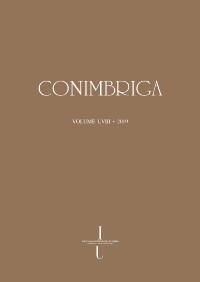Please use this identifier to cite or link to this item:
https://hdl.handle.net/10316.2/47569| DC Field | Value | Language |
|---|---|---|
| dc.contributor.author | Fernandes, Lídia | - |
| dc.contributor.author | Cachão, Mário | - |
| dc.contributor.author | Fernandes, Isabel | - |
| dc.contributor.author | Pimentel, Nuno | - |
| dc.contributor.author | Ribeiro, Maria dos Anjos | - |
| dc.date.accessioned | 2019-11-11T11:45:47Z | |
| dc.date.accessioned | 2020-09-23T18:38:26Z | - |
| dc.date.available | 2019-11-11T11:45:47Z | |
| dc.date.available | 2020-09-23T18:38:26Z | - |
| dc.date.issued | 2019 | - |
| dc.identifier.issn | 0084-9189 | - |
| dc.identifier.issn | 1647-8657 (PDF) | - |
| dc.identifier.uri | https://hdl.handle.net/10316.2/47569 | - |
| dc.description.abstract | Analisa-se um conjunto de elementos arquitetónicos de época romana recolhidos nas intervenções arqueológicas realizadas no teatro romano. Estas peças destacam-se pelo facto de o material em que são elaboradas não ser o biocalcarenito de idade miocénica, empregue em todos os elementos decorativos e estruturais do teatro mas antes um litótipo distinto, pouco homogéneo e exótico, quer na cor quer na composição. A singularidade destes elementos arquitetónicos é sublinhada pelo facto de serem os únicos que se reconhecem no monumento cénico e na cidade de Felicitas Iulia Olisipo / Lisboa realizados neste tipo de matéria-prima. Sublinha- se também o facto de todos estes elementos terem sido originalmente estucados, sendo possível, pelas suas características técnicas e estilísticas, atribuí-los ao primeiro momento construtivo do monumento cénico. | por |
| dc.description.abstract | A set of architectural elements from the Roman Theatre of Lisbon are described and analysed. These elements stand out for the material they are made of an exotic rock with both colour, composition and heterogeneity very distinct from the local lithotypes. The singularity of these elements is underlined by the fact that they are the only architectural remains recognized in the scenic monument and in the city of Felicitas Iulia Olisipo / Lisboa carved in this type of material. Worth noting, the fact of all these elements having been originally covered with stucco which considering their technical and stylistic features, could be assigned to the constructive moment of the decoration of the scenic monument. | eng |
| dc.language.iso | por | - |
| dc.publisher | Imprensa da Universidade de Coimbra | - |
| dc.rights | open access | - |
| dc.subject | roman theatre | eng |
| dc.subject | architecture | eng |
| dc.subject | mouldings | eng |
| dc.subject | plaster | eng |
| dc.subject | teatro romano | por |
| dc.subject | arquitetura | por |
| dc.subject | molduras | por |
| dc.subject | estuque | por |
| dc.title | Elementos arquitetónicos do Teatro Romano de Lisboa / Olisipo: sobre o emnprego de estuque e da pedra | por |
| dc.title.alternative | Architectural elements from the Roman Theatre of Lisboa / olisipo: plasters and stones | por |
| dc.type | article | - |
| uc.publication.collection | Conimbriga vol. 58 | - |
| uc.publication.firstPage | 149 | - |
| uc.publication.lastPage | 191 | - |
| uc.publication.location | Coimbra | - |
| uc.publication.journalTitle | Conimbriga: Revista de Arqueologia | - |
| uc.publication.volume | 58 | por |
| dc.identifier.doi | 10.14195/1647-8657_58_5 | - |
| uc.publication.orderno | 5 | - |
| uc.publication.area | Artes e Humanidades | - |
| uc.publication.manifest | https://dl.uc.pt/json/iiif/10316.2/47569/237679/manifest?manifest=/json/iiif/10316.2/47569/237679/manifest | - |
| uc.publication.thumbnail | https://dl.uc.pt/retrieve/11577067 | - |
| item.fulltext | With Fulltext | - |
| item.grantfulltext | open | - |
| Appears in Collections: | Conimbriga | |
Files in This Item:
| File | Description | Size | Format | |
|---|---|---|---|---|
| elementos_arquitetonicos_do_teatro_romano_de_lisboa.pdf | 6.28 MB | Adobe PDF |  |
Items in DSpace are protected by copyright, with all rights reserved, unless otherwise indicated.
